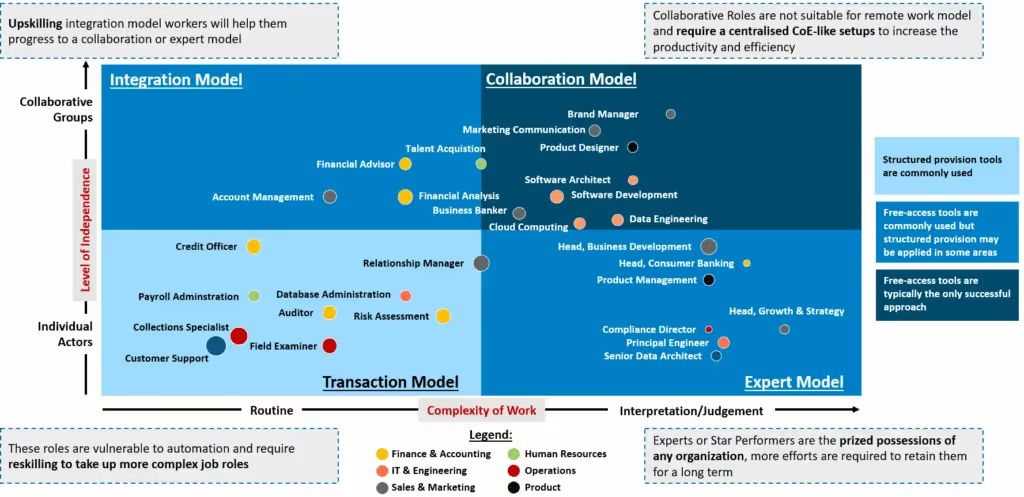Critical Labor Trends & Reimagining Skills Availability
Professor Veezhinathan Kamakoti from the Indian Institute of Technology proposes an interesting theory regarding enterprise skills-building. Dr. Kamakoti defines it as the Apple-Knife-Stone theory. To cut the Apple, you need the knife, but to keep the knife sharp, you need the stone. This simple theory has profound meaning and implications for Enterprises. There are certain foundations that organizations need to ensure to compete and innovate. Six months have elapsed in 2022. Let us look at critical labor trends at the top of the executives’ minds. The following are the macro trends based on our interviews across the regions.
- The job market continues to be very strong for technological and digital skills. There are signals of layoffs, but across regions, there is no slow down in Job postings (through inspecting our job postings database)
- Companies are attempting to bring the workforce back to the office. Our interviews show that the companies achieve about 25% back-to-office results. Still, a long way to go from this standpoint
- Companies are truly beginning to embrace the cloud ecosystem in skills building, especially learning. In my discussions with L&D leaders, they realize the strength and weaknesses of various content providers. This trend is very healthy; I see a difference from earlier. The infrastructure for skills transformation is truly here. There is still some work to be done to map the skills transition, but we can undoubtedly cross that bridge
- A Flight to Quality Moment: Palo Alto networks CEO Nikesh Arora says that this is a flight to quality moment, meaning sturdy companies can win back talent that fled during the great resignation
- Product Management Skills are going to be very crucial. Companies need to ruthlessly prioritize and refine their ambitions, whether a software product or a solution you take to a customer. Wild experiments may have to stop temporarily
- The way we work has changed. On my trips to meet with clients, we see how much companies invest in collaborative workspaces. Set schedules are a thing of the past, and asynchronous work is getting the norm
- Last week, Japan’s health ministry presented a draft plan Monday to recommend companies disclose their policies on whether they allow employees to have side jobs and the conditions for permitting them. The Poly work model may emerge as a norm.
- Companies are worried about the Supply Chain issues, and the potential winter energy crisis in certain parts of Europe is also in the minds of top executives
- Countries like Germany and Canada work hard to benefit from skilled labor migration. As Africa evolves with more Digital skills, these countries may benefit from the foundation they are laying even further
- In many global countries, smaller locations are beginning to emerge, but still, the tactical challenges persist in taking advantage of the talent pool fully
- The employee value proposition has significantly changed. Companies are doing significant research in terms of understanding expectations.
- Sales skills are at the top of the mind for many leaders as they expect to face market challenges across domains
- Cyber Security skills shortage is projected to get worse. The geopolitical challenge in Ukraine contributes to this as the region has excellent Cybersecurity talent
- The gig worker model is expected to increase, but companies have not fully integrated this into the core labor strategy
- DEI expands the boundaries; in countries like India, companies are beginning to think about social inequalities and how a positive impact can be made. General Motor Egypt is recruiting, training, and retaining women technicians in its workforce to create a gender-diverse workforce. It is the first company in Egypt’s automotive industry to recruit women for blue-collar roles
Against this backdrop, we recommend that the following labor strategies could benefit companies in the second half of 2022. We recommend the following essential action items
A supply chain view of Skills: A Workload view rather than a Job Description view
Enterprises have very extensive job descriptions. The problem with job descriptions is that they can be very confusing. Suppose you have a job description of a software developer, and you see skills like Angular JS; other than knowing the keywords, there is no context in the descriptions. One of the critical contributions of Draup has been around the granular definition of the skills and workloads. It will be helpful for HR to work on and define these Workload Views. Here is an example of Digital Workload mapping.

So decoding a skill like this, rather than handing over only a term like React JS, makes the Recruiter powerful. Also, the Job descriptions will be compelling.
We recommend building this view for each of the Digital Workloads that can be subsequently mapped to location hotspots. We can build this across all skills in Finance, Marketing, Human Resources, and other functions
We can then develop a comprehensive dashboard across the dashboards for the relevant talent. Whether it is Work Redefinition or Talent Architecture, this activity will be beneficial

Developing Planning Zones as per workloads/skills and roles
Such workloads can be mapped to roles, and zones of Collaboration and Transaction can be developed. For each zone, locations/regions/automation approaches can be mapped. New regions emerging in smaller cities in the US, South East Asia, and Africa are great opportunities for Transaction Zone. Depending upon the Roles mapped, we can arrive at location choices (both short-term and long-term).











.svg)




















.svg)





.svg)
